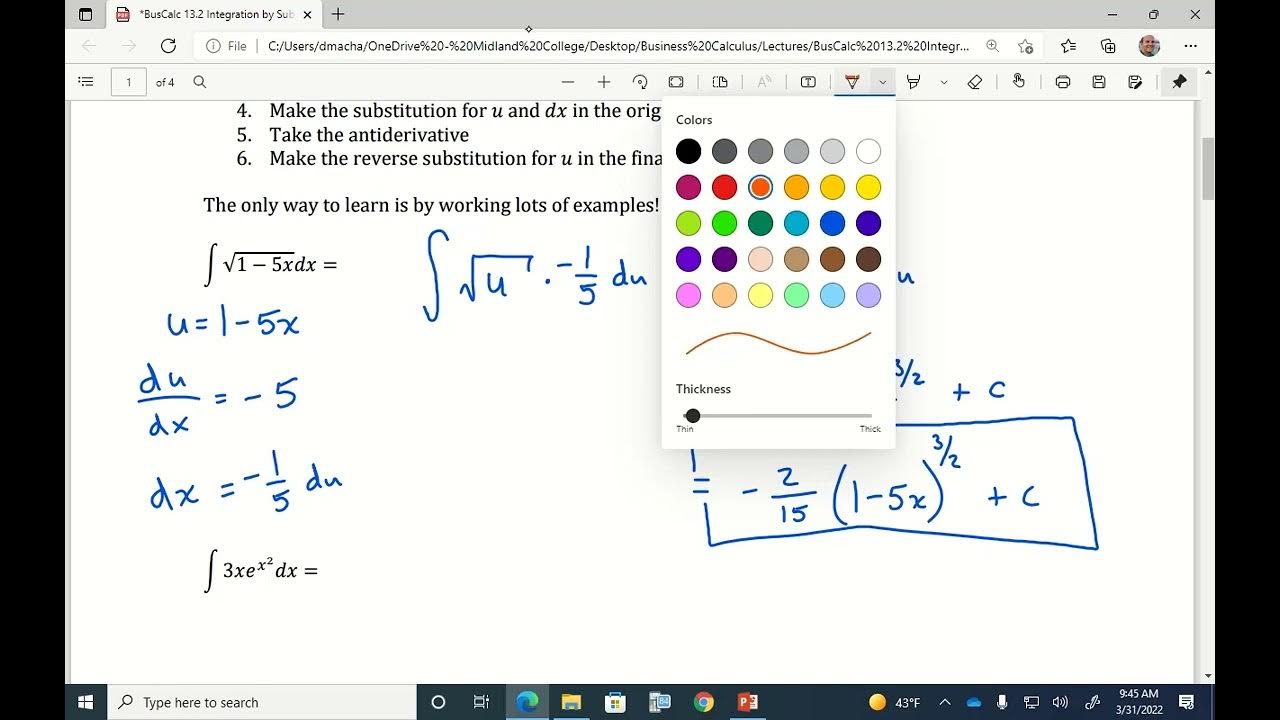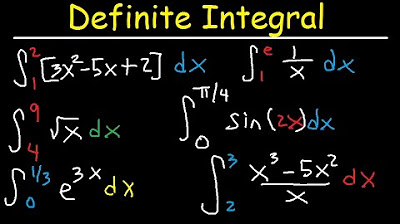U-Substitution
TLDRThis video explores the concept of u-substitution in calculus, focusing on anti-differentiating composite functions. It reverses the chain rule to simplify complex integrals, demonstrating strategies like perfect matches and non-perfect matches. The instructor also covers definite integrals and emphasizes the importance of practice for mastering u-substitution techniques.
Takeaways
- 📚 The video is an educational tutorial focusing on the concept of U-substitution in calculus, specifically for anti-differentiating composite functions.
- 🔄 The presenter discusses reversing the chain rule to find anti-derivatives, emphasizing the process of recognizing and substituting the inner function with a new variable, U.
- 📉 The video outlines a structured approach to U-substitution problems, including assigning U to the inner function, taking its derivative with respect to X, and manipulating the integral accordingly.
- 🔑 The key formula derived from the chain rule is highlighted: the integral of f'(G(x)) * G'(x) dx should yield back F(G(x)) when reversed.
- 📝 Examples are provided to demonstrate 'perfect matches' and 'not quite perfect matches' in U-substitution, showing how to adjust the process when the integral does not directly match the expected form.
- 🔍 The importance of recognizing the correct U for substitution is stressed, especially when the derivative of the inner function appears multiplied by the outer function.
- 📉 The presenter provides step-by-step solutions to several integral problems, illustrating the process of U-substitution and back-substitution to express the final answer in terms of the original variable.
- 📝 The video includes practice problems for viewers to attempt on their own, with the solutions provided afterward to check understanding and progress.
- 📌 A special note is made about the importance of correctly identifying when to use U-substitution, as it is not always the appropriate method for every integral problem.
- 📊 The tutorial also covers definite integrals with U-substitution, showing how to adjust the bounds of integration when changing variables.
- 📘 The video concludes with a reminder that practice and experience are crucial for mastering U-substitution, and it is a technique that may be revisited in more advanced calculus studies.
Q & A
What is the main focus of the video?
-The main focus of the video is to discuss U-substitution, a method used in calculus to simplify the process of anti-differentiating composite functions.
What is the chain rule in calculus?
-The chain rule states that the derivative of a composite function f(g(x)) is the derivative of the outer function f evaluated at g(x), multiplied by the derivative of the inner function g(x).
How does the process of U-substitution relate to the chain rule?
-U-substitution is essentially reverse engineering the chain rule. It involves setting U equal to the inner function of a composite function, finding the derivative of U with respect to x, and then using this to simplify the integral.
What is the first step in the U-substitution process?
-The first step in U-substitution is to let U equal the inner function of the composite function you are trying to anti-differentiate.
Why is it important to multiply both sides by dx in the U-substitution process?
-Multiplying both sides by dx helps to isolate the differential dx, which is necessary for making the substitution into the integral and simplifying the expression.
What is the purpose of replacing the underlined terms in the integral with U?
-Replacing the underlined terms with U simplifies the integral into a form that is easier to anti-differentiate, as it isolates the variable U and its derivative.
How does the video demonstrate the concept of 'perfect match' in U-substitution?
-The video demonstrates 'perfect match' by showing cases where the derivative of the inner function appears as a factor in the integral, making it straightforward to set up the substitution.
What is the significance of checking the anti-derivative by taking its derivative?
-Checking the anti-derivative by taking its derivative is a way to verify that the anti-derivative is correct. It should yield the original function when differentiated.
What is the difference between a 'perfect match' and 'not quite a perfect match' in U-substitution?
-A 'perfect match' in U-substitution refers to cases where the derivative of the inner function directly matches the form needed for substitution. 'Not quite a perfect match' refers to cases where additional algebraic manipulation is needed to make the substitution work.
Why is it recommended to convert the bounds of the integral to U values in definite integrals?
-Converting the bounds to U values in definite integrals helps to simplify the evaluation of the integral by keeping the process consistent with the substitution method and reducing the chance of errors.
What is the role of U-substitution in solving definite integrals?
-U-substitution is used in solving definite integrals to transform the integral into a more manageable form. It allows for the evaluation of the integral by changing the variable of integration, which can simplify complex integrals.
Outlines
📚 Introduction to U-Substitution and Anti-Differentiation
The video begins with an introduction to U-substitution, a technique used for anti-differentiating composite functions. The presenter aims to expand the viewer's ability to reverse engineer the chain rule for anti-derivatives. The chain rule is reviewed, emphasizing the process of taking the derivative of the outer function and multiplying by the derivative of the inner function. The video then outlines a structured approach to U-substitution, starting with setting U equal to the inner function, taking its derivative, and manipulating the integral to isolate terms involving U's derivative. The process is illustrated with an example involving the anti-derivative of a composite function, leading to the discovery of the anti-derivative through U-substitution.
🔍 Perfect Match U-Substitution Examples
This section delves into 'perfect match' U-substitution scenarios where the derivative of the inner function directly corresponds to the outer function's derivative. The presenter demonstrates the process with an example involving the anti-derivative of (x^2 + 1)^4 multiplied by 2x. The steps include setting U to the inner function, deriving U with respect to x, and adjusting the integral to match terms that can be replaced by dU. The anti-derivative is then found by integrating with respect to U and substituting back to the original variable. The presenter also provides practice problems for viewers to apply the technique on their own.
🔧 Non-Perfect Match U-Substitution and Adjusting Integrals
The video continues with cases where the U-substitution is not an immediate perfect match, requiring some algebraic manipulation to fit the U-substitution criteria. The presenter shows how to adjust the integral by dividing through by a constant to make the match perfect, then proceeds with the substitution. An example is given where the integral involves x times (x^2 + 1) to the power of 4, which requires rewriting and dividing by two to match the derivative of U. The anti-derivative is then found in terms of U and substituted back to the original variable, x. The presenter emphasizes the importance of practicing these techniques for mastery.
⚙️ U-Substitution with Linear Inner Functions
In this part, the presenter discusses U-substitution when the inner function of the composition is linear. The video explains that anti-differentiating functions like the cosine of a linear function can be approached with U-substitution, even if it's not a perfect match. The example given involves anti-differentiating the cosine of 5x, where U is set to 5x, and the integral is adjusted by solving for dx in terms of du. The presenter shows that after substitution, the integral simplifies to a standard form that can be easily anti-differentiated, and the result is then expressed in terms of the original variable.
📉 Definite Integrals and U-Substitution
The focus shifts to definite integrals and how U-substitution can be applied to evaluate them. The presenter illustrates this with an example where the integral involves 1/(U'/U), with U being the denominator. The bounds of integration are converted from x values to U values, and the integral is then anti-differentiated with respect to U. The final step involves evaluating the anti-derivative at the new bounds and simplifying the result using logarithmic properties. The presenter advises against applying complex log properties to match multiple-choice answers in exams.
📝 Practice Problems and U-Substitution Scenarios
The video concludes with a set of practice problems for viewers to apply what they've learned about U-substitution in various scenarios, including definite integrals. The presenter provides guidance on how to approach these problems and the importance of practicing to gain confidence and experience. The video also touches on problem types involving graphs or tables where U-substitution is required, and the presenter demonstrates how to work through these, emphasizing the need to convert bounds and integrals entirely to U for consistency and accuracy.
Mindmap
Keywords
💡U-Substitution
💡Chain Rule
💡Anti-Derivative
💡Composite Functions
💡Derivative
💡Integral
💡Perfect Match
💡Not Quite a Perfect Match
💡Definite Integral
💡Logarithmic Properties
Highlights
Introduction to the concept of U-substitution for anti-differentiating composite functions, expanding the library of functions that can be anti-differentiated.
Explanation of the chain rule in reverse for anti-differentiation, emphasizing the process of reversing the chain rule to find anti-derivatives.
The structure for U-substitution problems, including setting U equal to the inner function and taking its derivative with respect to X.
Multiplying both sides of the derivative equation by DX as a method to facilitate the change of variables in integration.
The importance of recognizing the same term on both sides of the integral to replace and simplify the expression.
The general approach to anti-differentiate composite functions by treating them as perfect matches or not quite perfect matches.
Demonstration of a perfect match case with the derivative of the inside of the composition being the same as the outside multiplied by the derivative.
The process of back-substituting U with its original function to express the anti-derivative in terms of the original variable.
The recommendation to practice U-substitution with various integrals to build confidence and experience in the technique.
The distinction between perfect and not quite perfect matches in U-substitution and how to handle them in anti-differentiation.
The strategy of making the integral a perfect match by solving for DX and adjusting the substitution factor.
Examples of U-substitution with linear inner functions, showing how to handle cases where the inner function is a simple expression like 5x.
The approach to definite integrals using U-substitution, including converting the bounds to U values and anti-differentiating within those bounds.
The caution against automatically applying U-substitution to every integral problem and the importance of recognizing when it is and isn't appropriate.
The demonstration of solving definite integrals with U-substitution, including finding the anti-derivative and evaluating it between the new bounds.
The presentation of practice problems for viewers to apply U-substitution on their own, fostering a deeper understanding of the technique.
The final summary emphasizing the importance of U-substitution in Calculus AB and the value of repeated practice for mastering the technique.
Transcripts
Browse More Related Video
5.0 / 5 (0 votes)
Thanks for rating:





